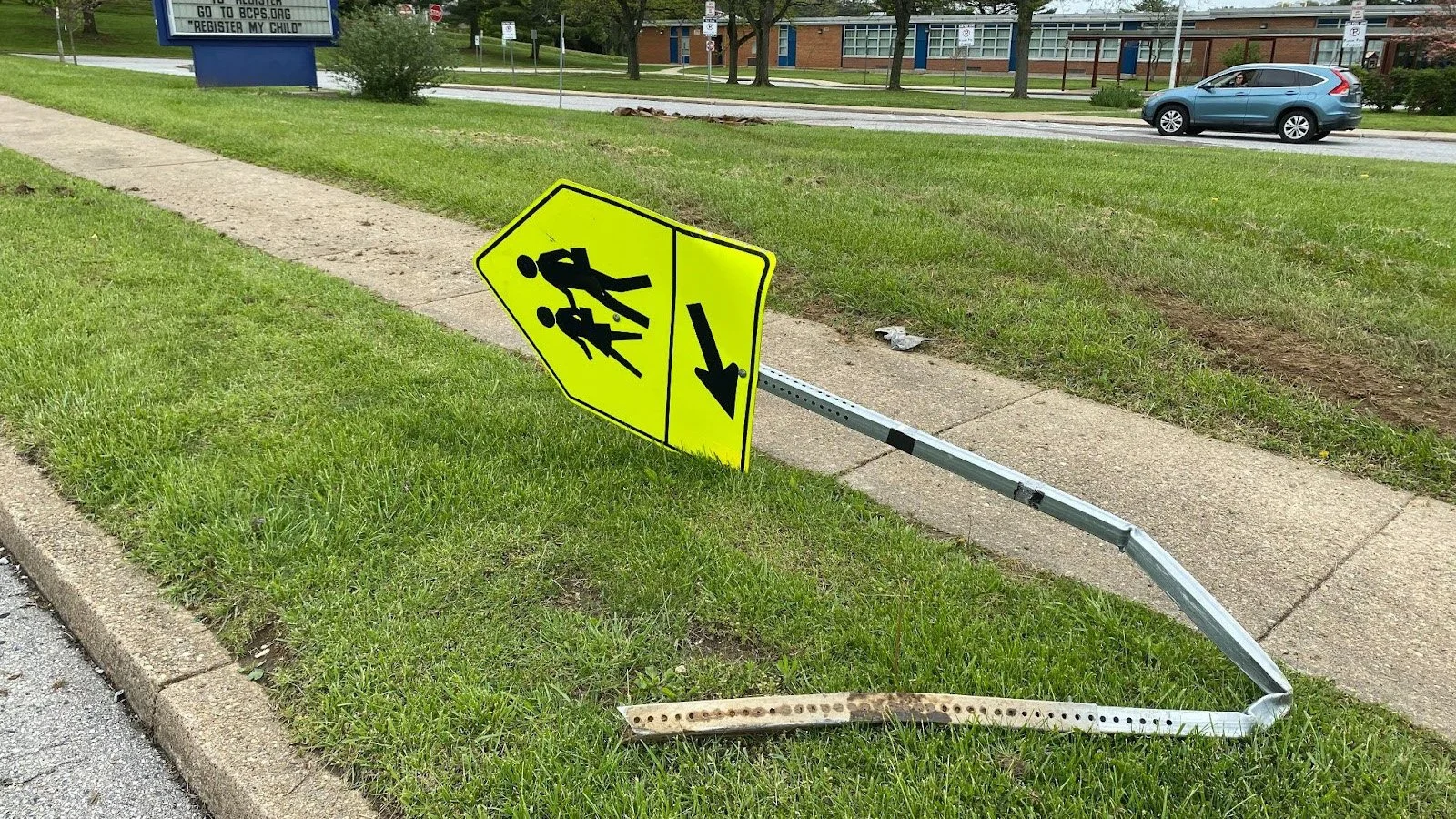Roundabouts and Raised Crosswalks Alone Won’t Slow Traffic
A damaged pedestrian site on Providence Road in Towson, MD, the site of multiple car crashes. (Source: Ralph Reitenbach.)
When 24-year-old Eliza Grover was tragically killed by a drunk driver along Providence Road in Towson, Maryland, people were outraged by the driver's irresponsibility. Social media comments, news articles, and locals alike condemned the driver's recklessness as they mourned the death of a beloved college student. But when neighbors talked to the media about the street Grover had been killed on, they questioned what could be done to the design of the road to ensure another devastating crash would not occur—whether a driver was operating a vehicle under the influence or not.
"What can we do about this road and the traffic? What can be done?" resident Ralph Reitenbach said to a news reporter the day after Grover’s crash.
“We’re concerned about the rush people are in and the unsafe conditions it seems living on this street presents and walking our children to school presents,” Alison Raskin told WBAL news.
Over the last decade, multiple people have been hit and seriously injured or killed along Providence Road. Just within the week of Grover’s death, one other person had been struck and injured. And despite locals expressing a need for a design that effectively slows traffic, they’ve been given a series of half-measures that haven’t stopped crashes. Instead of truly changing the design of the street to affect driver behavior, the county has implemented designs that still appear to prioritize traffic speed.
“We live right across from the elementary school. And we've had numerous injuries and deaths occur right in front of the school. You can blame it on the drivers, potentially. But it's really the way the road functions in a neighborhood,” said Reitenbach.
When Grover was hit, she was standing on the sidewalk next to a raised crosswalk before the driver jumped the curb, hit a pedestrian sign, and Grover. The crosswalk, which is next to the elementary school, is newly designed with paint and inclined red brick to draw more attention to the area. Yet people walking across are still exposed to traffic for the same amount of time as the old crosswalk, and drivers still speed.
“They didn’t put a speed bump like you typically might find on a residential street,” said Reitenbach. “All they did was raise it up about six inches, and it's approximately two feet wide. Even big tractor trailers go flying over. It doesn't slow anybody down.”
In fact, many other vehicles have skidded over the curb. In these instances, no one happened to be standing on the sidewalk, but the same pedestrian sign was still struck.
(Source: Ralph Reitenbach.)
Reitenbach has lived on Providence Road for over 12 years, and within that time, he’s witnessed multiple crashes; at least three of them resulting in death or serious injury.
Before the crash involving Grover, Reitenbach and local elementary students stood witness to the local crossing-guard being hit and life-flighted for medical care. This crash happened just up the road where the city has since installed a roundabout in an attempt to calm traffic. The crossing guard survived, but that did not ease the nerves of anyone within the neighborhood.
After the roundabout was installed, Reitenbach tested traffic speed with his own radar gun. Just like the crosswalk, he discovered the traffic-calming design didn’t work. He recorded cars regularly going 5–15 mph above the posted 30 mph speed limit.
“Almost consistently it's an exception when they go the speed,” said Reitenbach.
A roundabout can be both safer and more comfortable for drivers and walkers alike, but only if the engineer designing it knows how to integrate walkability into its design. This roundabout still has wide lanes and it does not prioritize or even equalize the environment for people walking. As seen on Google Maps, as of early 2024 or about three years after the crossing guard was hit, the roundabout has only one dedicated, fully painted crosswalk.
Along with being witness to the crash involving the crossing guard and the crash with Grover, Reitenbach has observed multiple other destructive incidents. Many times, drivers have lost control of their vehicle and slammed into pedestrian signage and skidded off into the grass. One vehicle even ended up only 50 feet away from the elementary school doors.
“Just the other day a driver came down and took a speed sign out,” said Reitenbach. “And the car kept going. They don't generally stop.”
(Source: Ralph Reitenbach.)
At one point, Providence Road had a speed camera, although it was removed after the crash with the crossing guard, whereupon the roundabout was installed. Reitenbach said that the speed camera seemed to help slow traffic, but only where drivers knew they could be captured on film. Once out of range of the camera, drivers would tend to speed back up.
Since the speed cameras seemed to have the most effect, residents along Providence Road hope the county will replace the ones removed and install more. Locals also intend to continue pressing the county for a design change that actually alters the geometry of the street and effectively slows traffic.
For example, even though Providence Road winds through a neighborhood, stretching between family homes and an elementary school, its wide lanes encourage speed similar to that of a highway. “It looks like it's like a four-lane road and it's really not,” said Reitenbach.
“We need to get our local county officials involved because having people die on residential streets is not a normal thing,” said Reitenbach. “It just shouldn't happen.”
If any city or county wants to be effective in creating a safer street, they’ll develop multiple responses to calming traffic, instead of relying on only one or two changes that still prioritize thru-traffic.
“You can't rely on a single thing to lower the speed,” Strong Towns Director of Community Action Edward Erfurt says. With an approach informed by tactical urbanism, the city could experiment with different street-calming measures until they reach a satisfactory outcome—all for a lower cost, as well.
And for the sake of everyone using the street, changes should be made quickly. No one wants another death in front of their home. “We had flowers to the left, we had flowers to the right. You shouldn't have flowers near your yard because someone died [on the street],” said Ralph Reitenbach.









Seairra Jones serves as the Staff Writer/Story Producer for Strong Towns. In the past, she's worked as a freelance journalist and videographer for a number of different organizations. She currently resides between small-town Illinois and the rural Midwest with her husband, where they help manage a family homestead. When Seairra isn’t focusing on how to make our towns stronger, you can find her outside working on the farm, writing fictional tales in a coffee shop, or reading in a hammock.